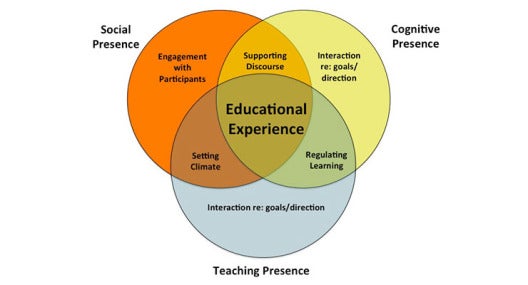Building Community Online
Renee M. Pilbeam, Ph.D. is in the role of Online Learning Manager – Special Projects and Strategic Initiatives at EdPlus at Arizona State University.
Building a sense of community amongst your learners in an online course can offer great benefits to your learners and their persistence in your learning experience while also creating a rich, dynamic, and inclusive learning experience with lasting benefits beyond the timeframe of the course.

Fostering a sense of community in an online course is often looked at as a bit of a daunting task and perhaps even as a limitation in learning online, but when you look at the rise of social media and the sense of connectedness that people can feel and crave in digital spaces, it becomes obvious how important this aspect of learning online is. When students feel connected to the course, the instructor, their peers and even a larger learning community, they are more likely to persist and thrive in an online learning space. In the following paragraphs we aim to share strategies for building community among your learners in an online course.
Opportunities for students to connect with one another while making meaning of and creating connections to the course content should be built into the design of the course, but the first public displays of this should come from the instructor. According to the article titled How to build an engaged online learning community by Olivia Molteno, students rank modeling by the instructor through their level of facilitation as the most important element in building community online (Bloom et. al, 2007). This same article goes on to cite that the three primary aspects of developing a learning community to consider are teaching presence, social presence, and cognitive presence (Garrison, 2007). Let’s explore each of these areas with considerations for how to incorporate this into both the course design and the learning experience.
Teaching Presence, also commonly referred to as instructor presence, is the primary way that an instructor can influence the sense of community in a course along with students’ perceived learning and satisfaction. Instructor Presence is achieved through a number of avenues including providing timely responses to course communications, giving personalized feedback on course assignments, facilitating discussions to encourage students to make new meaning, seek clarity on the topic, redirecting when the discussion moves off-track, and showing that you are actively reading and considering what students are posting. Discussions are often the primary way to engage in this area and at ASU Online, we use a number of tools that suit different disciplines to achieve this, like Yellowdig, Piazza, and Slack.
Social Presence is the ability for students to find commonalities with and engage with their peer group of learners while also contributing to the shared meaning making of the course content. It also positions students as contributors to the learning experience. Opportunities for students to explain their ideas and individual interpretations of the course materials to their peers allows students to both engage deeply with the course material while also building relationships with their peers. This can lead to increased engagement as well as a support system for students when they are struggling with the course materials. Having an established relationship with their peers provides an additional source of encouragement and assistance when it is needed. As an instructor you can create opportunities for students to interact with one another through carefully crafted discussion prompts, including opportunities for collaboration, encouraging learners to connect with other classmates that share similar life experiences and by modeling what engaged and respectful dialogue looks like in course discussions.
Cognitive Presence is the process through which students make meaning of and construct their knowledge on a subject or topic. Through critical engagement with the content paired with opportunities to share and build upon their own interpretations and meaning of the content, cognitive presence is fostered. Not only can this lead to greater understanding of the topic/subject, it builds community while the learners share and shape their take on the content being presented. One way to achieve this is through classic discussion boards where questions are constructed and presented in a way that allows learners to build their own knowledge within their current contexts and knowledge frameworks, while also being able to view and interact with their peers’ interpretations of the same content. The most important factor here is the instructor’s ability to guide the learners through this process modeling the ability to ask probing questions, evaluate other interpretations, and provide additional information/insight to get learners to the desired end point in their learning.

All three of these aspects are critically important to the establishment of a learning community in a course. At the center of where the three overlap lies the educational experience.
In all of these areas, it is important that the interactions that happen online all serve the purpose of achieving learning and fostering a sense of community. Additionally, the instructor should make efforts to foster the below:
- Inclusive Course – Let students know that their perspectives, stories, lived experiences are valuable and that the sharing of their diverse ideas are valued, celebrated, and critical to the learning community in the course
- Relationship Building – both amongst students and with the instructor. A “hallway conversations” or “coffee chat” discussion space can be used to create connections outside of the course materials
- Trust Building – Displaying an openness to differing opinions, an examination of self, vulnerability, and their humanness in a warm environment
- A balance between formal and informal interactions to create space for both the academic and personal pieces of the learning experience
- Clear direction through modeling, redirecting, clarification, establishing clear communication expectations
- Personalized Guidance – Directly (and privately) reach out to and guide students who post too often, not enough or offend the expected netiquette protocol
The development of a thriving learning community lies largely in the instructor’s hands, especially at the beginning, but has potential to influence learners’ learning experience and lives far beyond their time in the course.
References:
Bloom, L., Sherlock, J. & Vesely, P. (2007). Key Elements of Building Online Community: Comparing Faculty and Student Perceptions. MERLOT Journal of Online Learning and Teaching. 3(3):234-246. https://jolt.merlot.org/vol3no3/vesely.htm?utm_source=nov+11+-+Building+Community+In+The+Online+Environment
Kuh, G. D. (2005). Student success in college: creating conditions that matter. San Francisco: Jossey-Bass.
Molteno, O. (2017, March 6). How to build an engaged online learning community. GetSmarter. https://www.getsmarter.com/blog/research-hub/how-to-build-an-engaged-online-learning-community/
Garrison, D. (2007). Online community of inquiry review: Social, cognitive, and teaching presence issues. Journal of Asynchronous Learning Networks. 11(1):61-72. http://files.eric.ed.gov/fulltext/EJ842688.pdf



